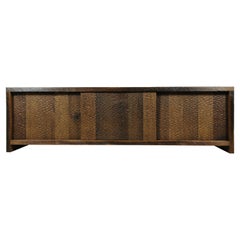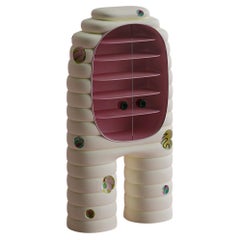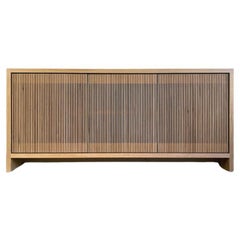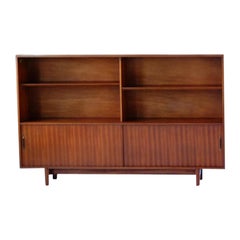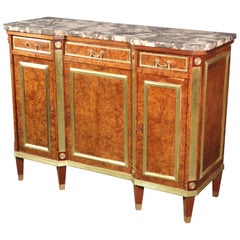Russian Sideboards
to
Height
to
Width
to
Depth
to
1
5
5
5
4
1
1
1
2,811
5,644
1,478
1,170
1,026
4
Place of Origin: Russian
Contemporary Sculpted Sideboard in Solid Oak and Linseed Oil
By Sóha
Located in Paris, IDF
Contemporary sculpted sideboard in solid oak and linseed oil.
Dimensions:
H. 85 x W. 160. x D. 45 cm
Unique piece made to order.
Founded ...
Category
21st Century and Contemporary Brutalist Russian Sideboards
Materials
Oak
Contemporary Sculpted Sideboard in Solid Oak, Light, Checkered Texture
By Sóha
Located in Paris, IDF
Contemporary Sculpted Sideboard in Solid Oak, Light Oak, Checkered Texture
Dimensions:
H. 60 x W. 200. x D. 55 cm
Unique piece made to order.
Founded by artist Denis Milovanov, S...
Category
21st Century and Contemporary Brutalist Russian Sideboards
Materials
Oak
Contemporary Brutalist Credenza in Solid Oak, 'Custom Size'
By Sóha
Located in Paris, IDF
Brutalist credenza in solid oak
Dimensions:
H. 50 x W. 160 x D. 45 cm
Unique piece made to order.
Founded by artist Denis Milovanov, SÓHA design studio conceives and prod...
Category
21st Century and Contemporary Brutalist Russian Sideboards
Materials
Oak
Sculpted Credenza 'Hammered' in Solid Oakwood 'Custom Size'
By Sóha
Located in Paris, IDF
Credenza, cabinet made of solid oak (+ linseed oil), with sliding doors
Made to order - Custom size
SÓHA design studio conceives and produces furniture design and decorative object...
Category
21st Century and Contemporary Brutalist Russian Sideboards
Materials
Oak
Homo Erectus Sideboard by Taras Yoom
Located in Geneve, CH
Homo Erectus Sideboard by Taras Yoom
Limited Edition of 3
Dimensions: D 45 x W 110 x H 190 cm
Materials: Metal, wood, enamel, lacquer, glass.
This is a wooden sculpture covered with...
Category
2010s Organic Modern Russian Sideboards
Materials
Metal, Enamel
$55,021 / item
Related Items
Oak Slatted Credenza / Sideboard - Fully Customizable
Located in Portland, OR
Solid wood credenza / sideboard with slatted screen doors in white oak built by Material in Portland, Oregon. The clean modern lines and quiet texture o...
Category
21st Century and Contemporary Minimalist Russian Sideboards
Materials
Oak
Mid-Century Modern Sliding Glass Door Bookcase Cabinet Robert Heritage
By Robert Heritage
Located in Leicester, GB
We can ship directly to you - please contact us with your country & postcode for an accurate delivery price. Shipping to the US £450 in a custom made crate
A beautiful long slim gla...
Category
1960s Mid-Century Modern Vintage Russian Sideboards
Materials
Hardwood
$808
H 40.16 in W 60.24 in D 10.63 in
Weave 196, Credenza from Ringvide. Solid Birch wood, natural oil. Scandinavian
By Lukas Dahlén
Located in Visby, SE
Weave 196 Birch natural oil
Birch credenza, made of solid birchwood and laminated birchveneér. Modern yet classic, bold yet modest the cabinet serves as a great example of scandinavian contemporary design. Designed by Lukas Dahlén.
The minimal yet expressive Weave credenza is made of solid birchwood and birchveneér. Inspired by the most common kind of wood and weed weaving the Weave credenza represents an enlarged version of the technique of weaving something soft around a more stable structure. The top and bottom plane of the credenza is held together by sticks kept together like a Windsor chair. Since first shown in Milan 2012, salone satellite, it has received a lot of attention worldwide.
Standard sizes:
Weave 196
Weave 133...
Category
2010s Scandinavian Modern Russian Sideboards
Materials
Birch
$8,950 / item
H 32.68 in W 77.17 in D 16.93 in
Mae Solid Walnut Credenza, Console, Sideboard by Crump and Kwash
By Crump and Kwash
Located in Baltimore City, MD
Solid wood case / hand-turned legs / hand rubbed oil finish / solid brass pulls / premium, full extension, soft close drawer slides / solid wood, dovetailed drawer boxes
Dimensions:...
Category
2010s Modern Russian Sideboards
Materials
Brass
$9,650 / item
H 30 in W 72 in D 18 in
Danish Modern Brutalist Credenza in Oak, 1960s.
Located in Asaa, DK
Danish Modern Brutalist Credenza in Oak, 1960s.
Beautiful and sculptural Mid-Century Modern Danish highboard in oak that offers plenty of storage space. Made in Denmark in the 1960s with intricate hand carved motifs and wrought iron drawer pulls.
This high sideboard could very well be designed by Henry/Henning Kjærnulf, as he is well known for combining baroque and early medieval...
Category
1960s Brutalist Vintage Russian Sideboards
Materials
Oak
Bookshelf by Sormani for Roche Bobois Green Lacquer and Stained Cherrywood, 1990
By Sormani, Roche Bobois
Located in Arosio, IT
This sculptural wave-shaped cabinet was designed by Emilio Rossi and produced by Sormani for the prestigious French brand Roche Bobois in Italy in the early 1990s. An exceptional exa...
Category
1990s Mid-Century Modern Russian Sideboards
Materials
Wood
$1,905 Sale Price
20% Off
H 49.22 in W 39.38 in D 20.48 in
Sideboard in Solid Oak, Kjærnulf style, Brutalist Cabinet 1960s
By EG Kvaliteet, Henning Kjærnulf
Located in Store Heddinge, DK
A majestic sideboard crafted in the style and quality of Henning Kjærnulf, this piece showcases exceptional craftsmanship in every detail. Made from...
Category
1960s Mid-Century Modern Vintage Russian Sideboards
Materials
Brass
Brutalist Solid Oak Sideboard, Spain, 19th Century
By BIOSCA
Located in Kaštel Sućurac, Splitsko-dalmatinska županija
"La perfection est dans l’imperfection même." — Victor Hugo
A striking example of Spanish craftsmanship, this monumental sideboard—measuring an impressive 98.5 inches (250 cm) in le...
Category
19th Century Brutalist Antique Russian Sideboards
Materials
Oak
Sculpted Cabinet Credenza by Jacques Jarrige
By Jacques Jarrige
Located in New York, NY
The meandering sculpture across the two sliding doors make this piece seem always in movement. Each sculpture cabinet is unique.
Category
2010s Russian Sideboards
Materials
Wood
Credenza Libreria Francese a Due Ante con Alzata a Vetrina 1870 Radica di Noce
Located in Milano, MI
Credenza Francese 1870 in Noce e Radica mobile antico a due corpi, con alzata a vetri, a due ante e due cassetti di epoca Luigi Filippo 1870 circa. Questa libreria francese a due cor...
Category
Late 19th Century Louis Philippe Antique Russian Sideboards
Materials
Glass, Oak, Poplar, Walnut, Burl
$2,977
H 98.04 in W 60.24 in D 25.2 in
Guillerme & Chambron Sideboard in Solid Oak and White Ceramic
By Guillerme et Chambron, Votre Maison
Located in Waalwijk, NL
Guillerme et Chambron for Votre Maison, sideboard, solid oak, ceramic, France, 1960s
This charming sideboard, designed by the talented designer duo Guillerme et Chambron, stands out...
Category
1960s Mid-Century Modern Vintage Russian Sideboards
Materials
Oak, Ceramic
$13,800
H 37.41 in W 102.96 in D 20.08 in
1940s, Art Deco Sideboard in Bleached Solid Oak and Marble
By Charles Dudouyt
Located in TARBES, FR
Magnificent sideboard in bleached solid oak with the tree inlaid in the doors, keyholes and brass key, very beautiful patina, some traces of wear and tear, Art Deco style, raw and ge...
Category
Mid-20th Century Art Deco Russian Sideboards
Materials
Marble
$2,054 Sale Price
75% Off
H 40.95 in W 74.02 in D 19.69 in
Previously Available Items
Russian Baltic Burled Walnut Marble-Top Louis XVI Style Buffet Sideboard C1850
Located in Swedesboro, NJ
This is a rare and desirable Russian sideboard. The case is fitted with the best brass and bronze ormolu of this form. The marble-top has a gorgeous ...
Category
1850s Louis XVI Antique Russian Sideboards
Materials
Walnut
H 38 in W 50 in D 19 in
Neoclassical Sideboard, circa Baltic/Russia, 1810-1820
Located in Greding, DE
Neoclassical sideboard probably from Baltic/Russia with gold details, two doors and fluting which has a golden patina. The coffered doors are outlined with a golden trim.
Category
1810s Neoclassical Antique Russian Sideboards
Materials
Wood
Neoclassical Sideboard, circa Baltic/Russia, 1810-1820
Located in Greding, DE
Neoclassical sideboard probably from Baltic/Russia with gold details, rwo doors and fluting which has a golden patina. The coffered doors are outlined with a golden trim.
Category
1810s Neoclassical Antique Russian Sideboards
Materials
Wood
Russian Neoclassical Style Marble-Top Console Table
Located in Manhasset, NY
Russian neoclassical marble-top console table. Tapering with cookie cutter inserts of bronze. The bronze sabots leading to a column continuation that holds an elongated drawer below ...
Category
Mid-17th Century Neoclassical Antique Russian Sideboards
Pair of Monumental 19th Century Russian Neoclassical Console Cabinets
Located in Manhasset, NY
Pair of 19th Century Russian Neoclassical Console Cabinets. The most incredible pair of monumental consoles seen anywhere. This fine pair of heavily bronze mounted cabinets support l...
Category
1860s Empire Antique Russian Sideboards
H 38.25 in W 64.25 in D 22.5 in
Russian Neoclassical Center Table
Located in Manhasset, NY
A marvelous Russian Neoclassical style center table, the white marble top with bronze gallery set on top of a mahogany frieze fitted with three drawers, each with bronze banding, oak...
Category
19th Century Antique Russian Sideboards
Materials
Bronze
Antique Hutch, Buffet
Located in Los Angeles, CA
Antique Hutch, Renaissance Revival. We have modified this cabinet so that it has adjustable/removable shelves and can also be used to house a large flat ...
Category
19th Century Antique Russian Sideboards
Materials
Pine, Birch
Large Buffet From Russian Castle
Located in Los Angeles, CA
Magnificently carved oak buffet with six doors and three drawers which are intricately detailed. The initials of the original owner, "MT", are carved in Cyrillic script on the center...
Category
19th Century Antique Russian Sideboards
Materials
Oak
Antique Sideboard
Located in Los Angeles, CA
Folk art painted sideboard with lots of character.
More pictures available upon request.
More pictures available upon request.
Category
19th Century Antique Russian Sideboards
Materials
Pine
Antique Hutch, Buffet. ca. 1870
Located in Los Angeles, CA
Antique Russian hutch with adjustable shelf. Note the solid dove-tail construction. Could be used to house a large flat screen TV.
Additional pictures available upon...
Additional pictures available upon...
Category
19th Century Antique Russian Sideboards
Materials
Pine
Small Painted Commode
Located in Los Angeles, CA
Painted 2-door cabinet with interior shelf. Great as small sideboard or large bedside cabinet. Very well built with dovetails all around.
Category
19th Century Antique Russian Sideboards
Materials
Pine
Painted Buffet
Located in Los Angeles, CA
Description: Antique buffet/hutch painted in traditional folk art design. We have modified this cabinet so that it has an adjustable/removable shelf. C...
Category
19th Century Antique Russian Sideboards
Materials
Pine
Recently Viewed
View AllMore Ways To Browse
Retro Mid Century Nathan Sideboard
Sanders Sideboard
Serpentine Mahogany 8 Drawer
Stag Sideboard
Antique End Table With Sliding Doors
Avalon Teak
Baker Mahogany Demilune Cabinet
Broyhill Sideboard
Butler Sideboard
Cantilever Sideboard
G Plan Bar Cabinet
Hans J Wegner Wall Mount Cabinets
Hepplewhite Display Cabinet
Jacobean Walnut Sideboard
Jean Michel Frank Sideboard
Maurizio Duranti
Peter Lovig Nielsen Sideboard
Rietveld Sideboard



